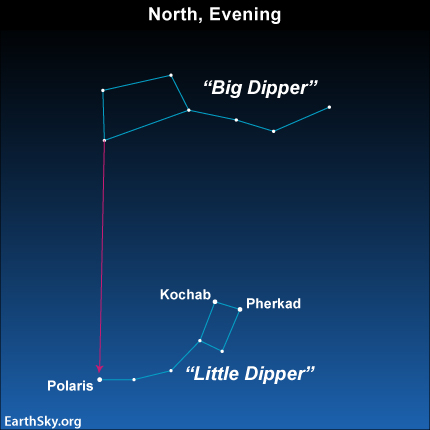
We received a question about the Big and Little Dippers:
How can I locate both Ursa Minor and Ursa Major? I am seeing one of them in the sky … but cannot tell which one and where the other one is.
If you’re seeing only one dipper, it’s probably the Big Dipper in the constellation Ursa Major the Greater Bear. This constellation contains the Big Dipper asterism that’s familiar to so many stargazers because it really does look like a dipper.
This is a great time of year to begin looking for the Big Dipper in the evening. Here it is, on today’s chart (above), shown ascending in the northeast in the evening at this time of year. You can pick it out easily.
The Little Dipper is harder. It’s not as dipper-shaped as its larger counterpart. The Little Dipper is part of the constellation Ursa Minor, the Lesser Bear. These stars are fainter, and the dipper shape isn’t so obvious. But the Little Dipper is easy to spot, once you realize that the North Star is the last star in the Little Dipper’s Handle.
In other words, find the North Star – Polaris – and you can always find the Little Dipper. How can you find the North Star? As today’s chart shows, the two outermost stars in the Bowl of the Big Dipper always point to the North Star.
That’s why these two stars, Dubhe and Merak, are known as The Pointers.
Enjoying EarthSky so far? Sign up for our free daily newsletter today!

Bottom line: Use the two outer stars in the Bowl of the Big Dipper to find the North Star, Polaris. The North Star marks the last star in the Handle of the Little Dipper.
EarthSky astronomy kits are perfect for beginners. Order today from the EarthSky store
Donate: Your support means the world to us
Read more about the Big and Little Dippers, noticeable in your northern sky











